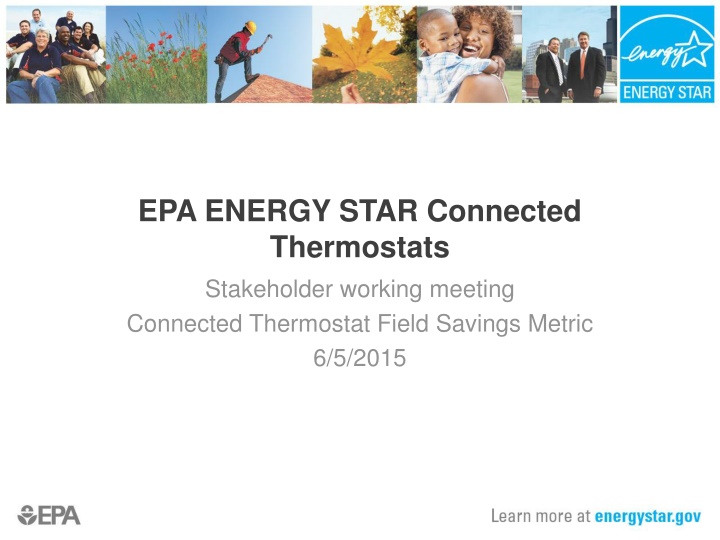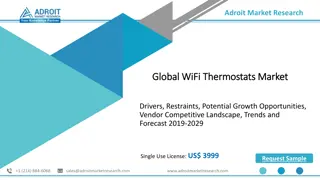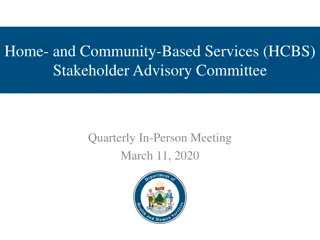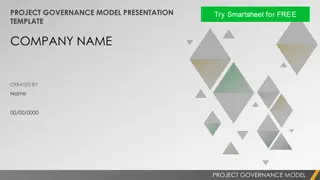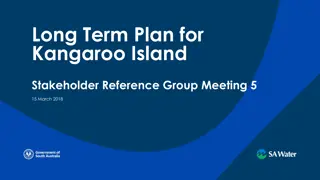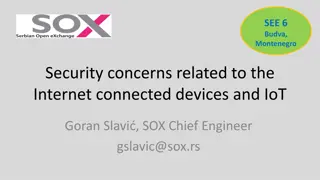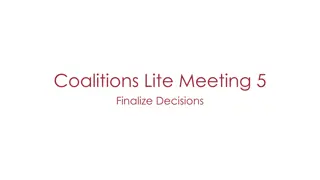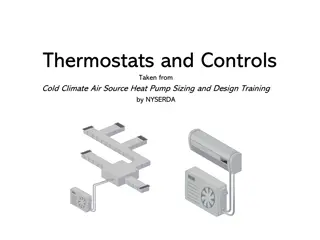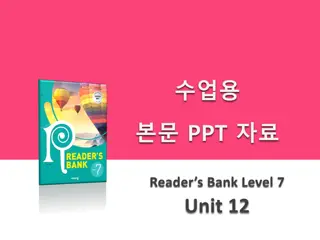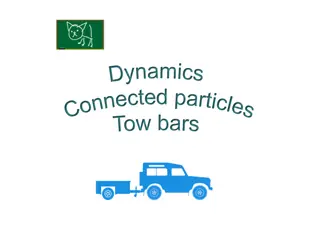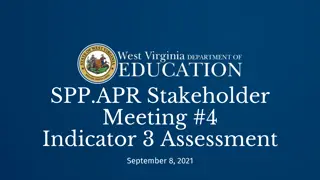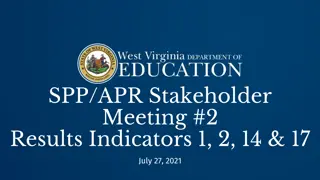Connected Thermostats Stakeholder Meeting Insights
In this stakeholder meeting, various topics such as administrative updates, data call results, accuracy of temperature readings, sharing of data sets, and discussions on temperature measurements accuracy were covered. Debates on regional baselines, outliers removal validity, savings drives, demographic influences, and locational baselines were highlighted. The session emphasized the need for careful data analysis and consideration of various factors affecting thermostat performance.
Download Presentation

Please find below an Image/Link to download the presentation.
The content on the website is provided AS IS for your information and personal use only. It may not be sold, licensed, or shared on other websites without obtaining consent from the author.If you encounter any issues during the download, it is possible that the publisher has removed the file from their server.
You are allowed to download the files provided on this website for personal or commercial use, subject to the condition that they are used lawfully. All files are the property of their respective owners.
The content on the website is provided AS IS for your information and personal use only. It may not be sold, licensed, or shared on other websites without obtaining consent from the author.
E N D
Presentation Transcript
EPA ENERGY STAR Connected Thermostats Stakeholder working meeting Connected Thermostat Field Savings Metric 6/5/2015
Agenda Administrative updates and issues Data call results, discussion Accuracy of temperature readings <#>
Administrative notes New web site referring to Connected Thermostats Documents previous to June 9 can be accessed on the original web site, referring to Climate Controls Some of the references at energystar.gov may take a week or two to be updated New email address operational in the next few days: connectedthermostats@energystar.gov Any issues? <#>
Data call 3 organizations have agreed to share submitted data. These three data sets have been shared Tentative conclusions about some hypotheses possible In depth discussion of hypotheses and conclusions next meeting Additional data may yet come in <#>
Data call discussion Are temperature measurements accurate? e.g. are the differences between vendors real? Surprised if there was a 1F overall bias for all thermostats, though there would be random variation Argument, if there is, for comparing thermostats to themselves However, if differences are due to demographic differences, the fairer thing to use is a regional baseline Single regional number biases who vendors want to sell to Set a deviance bound if a particular home s baseline is outside of it, default to regional baseline Is removing outliers ever valid? warning Definitely needs to be done carefully <#>
Data call discussion Difference between 90thpercentile and average is somewhat indicative of setback behavior Assertion that this difference drives the savings But if driven by demographics alone then what do we attribute to the tstat? RCT and before-after studies show actual savings Non-fixed climate zone model, using data from vendors Baseline based on demographics of the zip code of the location of the t stat Locational baseline much finer scale based on publicly available demographic data. E.g. income, 2ndhome percentage, retirees, HDD per year Are zip codes a good proxy, though? Lots of heterogeneity within zip codes, but are differences between larger Agreed that it would be closer, but more complex, may be small numbers in each zip code <#>
Data call discussion RBSA data that is not smart t-stat data. Is size of set point effect large compared to what we see in a data set that is without smart t stats Fraunhoefer study very little setback occurs Difference between average and 90thand average and 10thfor RBSA data (or the metric) to see if the control group is very different than what we are seeing from these three excellent t stats Initial analysis of RBSA data does show a difference between average indoor temp and temperature preference How directly comparable is this to the data from this data call <#>
Data call discussion Where can we find indoor temp datasets? Alarm companies with data? With remote access tstats in their package? [alarm.com, ADT Pulse, Shclage, iControl to make connections] Homes with data loggers from utilities? DR companies? (Other than those working on EE?) RBSA shows setback behavior across the board similar to data set 1 Comparison of pacific NW to all of cold climate not valid Looked at differences between zip codes within the same state, 4-5 F differences in average RBSA data: 68.8 F average indoor temp, 90thindoor temp 71.6 F; filtered for the heating season (not easy to describe, but meant to be comparable to the run time method); std. errors around 3 F for each Some marine and some cold climate zone, 50% - 65% in the marine zone Assertion that this data shows that climate zone is too coarse a comparison. May also want to try to analyze infrequently occupied homes differently. <#>
Data call - discussion Tstats will look better or worse depending on their customer s ability to choose energy saving schedules Fundamental issue is to try to correct for that zip code level data would be an attempt to do that Seriously easier if we can mostly use census data Derived products available that are close to demographics at the zip code level None of this is relevant if we can rely entirely on per- home baseline main problem with that is not rewarding induced differences in preference temperature Differences in outdoor temps (and maybe set points) may be largely based on different geographic clustering <#>
Action items Can we establish why data set 3 has so much larger std. error? Yellow cells in spreadsheet show anomalies please check your sets Also can check indoor temp data against RBSA data with more regional accuracy Can BPA give us results broken down within each climate zone? Really small sample sizes probably not worth it May be worth looking for additional indoor temperature only data sets <#>
Temperature measurement accuracy Starting point: NEMA DC-3 test method and requirements Static temp accuracy 1 F after 1 hour soak Droop <1.5 F, measured as difference of cut-in temp when room temp ramps up and when it ramps down Droop is the effect of internal heating in the thermostat; it has (2) undesirable effects: Displayed/reported room temp is warmer than actual There is a droop in the cut-in point so the room is cooler than desired How much accuracy is needed to make comparisons between vendors accurate? Do static temperature accuracy and droop adequately capture measurement accuracy in the field? <#>
From NEMA DC3, Annex A-2013: A.13.3 Room Temperature Droop Heating Operation For the 20% duty cycle, ramp rate shall be 8 F (4.4 C) / hour up and 2 F (1.1 C) / hour down. For the 80% duty cycle, ramp rate shall be 2 F (1.1 C) / hour up and 8 F (4.4 C) / hour down. The effective value of room temperature droop is the difference between the cut-in points at the 20% duty cycle and the 80% duty cycle. A.13.4 Room Temperature Droop Cooling Operation For the 20% duty cycle, ramp rate shall be 2 F (1.1 C)/hour up and 8 F (4.4 C)/hour down. For the 80% duty cycle, ramp rate shall be 8 F (4.4 C) /hour up and 2 F (1.1 C) / hour down. The effective value of room temperature droop is the difference between the cut-in points at the 20% duty cycle and the 80% duty cycle. A.14 STATIC TEMPERATURE ACCURACY The static temperature measurement accuracy shall be determined by holding the unit in a temperature chamber for one hour at 70 F (21 C), and comparing the display value to the chamber setpoint [70 F (21 C)]. <#>
Temperature accuracy discussion Accuracy not necessary it s the systematic differences that are important. But vendors are best equipped to correct for that <#>
Running parking lot Zoned systems? Usually not integrated. Multiple systems in one home? Ask for statistics about how common this is. Definition of a product e.g. enrollment in peak control service makes it a different product Verification and gaming the system? Does the customer base bias the metric results, aside from the qualities of the products? Add on today s parking lot items <#>
Contact Information Abigail Daken EPA ENERGY STAR Program 202-343-9375 daken.abigail@epa.gov Doug Frazee ICF International 443-333-9267 dfrazee@icfi.com <#>
